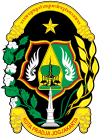|
||||
| Nickname(s): Kota Pelajar (Student's City) or Kota Gudeg (Gudeg City) | ||||
| Motto: Memayu Hayuning Bawono | ||||
| Coordinates: 7°48′5″S 110°21′52″ECoordinates: 7°48′5″S 110°21′52″E | ||||
| Country | Indonesia | |||
|---|---|---|---|---|
| Province | Yogyakarta Special Region | |||
| Government | ||||
| - Mayor | Herry Zudianto | |||
| Area | ||||
| - City | 32.5 km2 (12.5 sq mi) | |||
| Population (2008) | ||||
| - Density | 11,941/km2 (30,927/sq mi) | |||
| - Metro | 1,588,622 | |||
| Time zone | WIB (UTC+7) | |||
| Website | www.jogjakota.go.id | |||
Orientation
The area of the city of Yogyakarta is 32.5 km². While the city spreads in all directions from the kraton (the Sultan's palace), the core of the modern city is to the north, centring around Dutch colonial-era buildings and the commercial district. Jalan Malioboro, with rows of pavement vendors and nearby market and malls, is the primary shopping street for tourists in the city, while Jalan Solo, further north, is a shopping district more frequented by locals. At the southern end of Malioboro, on the east side is the large local market of Beringharjo, not far from Fort Vredeburg a restored Dutch fort.
At Yogyakarta's centre is the kraton, or Sultan's palace. Surrounding the kraton is a densely populated residential neighbourhood that occupies land that was formerly the Sultan's sole domain. Evidence of this former use remains in the form of old walls and the ruined Taman Sari, built in 1758 as a pleasure garden. No longer used by the sultan, the garden had been largely abandoned. For a time, it was used for housing by palace employees and descendants. Reconstruction efforts began in 2004, and an effort to renew the neighbourhood around the kraton has begun. The site is a developing tourist attraction.
Nearby to the city of Yogyakarta is Mount Merapi. The northern outskirts of the city run up to the southern slopes of the mountain in Sleman Regency (Indonesian language–Kabupaten). Gunung Merapi (literally Mountain of Fire in Indonesian/Javanese), is an active Stratavolcano located on the border between Central Java and Yogyakarta, Indonesia. It is the most active volcano in Indonesia and has erupted regularly since 1548. The volcano last erupted in November 2010.
Arts and culture
Yogyakarta has strong communities in:- silver work,
- Traditional leather puppetry used for shadow plays (wayang kulit),
- Contemporary puppetry and theatre, for example Papermoon Puppet Theatre [2]
- Making batik dyed fabric. It is also known for its vivid contemporary art scene.
- gamelan music, including the unique style Gamelan Yogyakarta, which developed in the courts.
- Yogyakarta is also a haven for underground art.
- Independent filmmaking communities,
- Independent musicians,
- Performance artists,
- Visual artists including Taring Padi community in Bantul, that produces art prints using a technique called cukil.
Demography and language
Most population is Javanese, but being a student city, there are also significant population of people from other ethnicities in Indonesia. This status makes Yogyakarta as one of the most heterogeneous cities in terms of ethnicity in Indonesia. Indonesian as the official national language, and Javanese are widely used as daily spoken languages, especially by the Javanese.Education
Yogyakarta is well-known as home of Gadjah Mada University,[3] one of Indonesia's most prominent state universities. The others public university in Yogyakarta are Yogyakarta State University,[4] Sunan Kalijaga State Islamic University,[5] Indonesia Arts Institute.[6] This city also houses several well known private universities such as Muhammadiyah University of Yogyakarta,[7] Islamic University of Indonesia,[8] Atma Jaya University[9] and Sanata Dharma University.[10]History
The root of the civil war started when Sunan Pakubuwono II agreed to cooperate with the Dutch colonial government and submit to foreign (western) powers. His younger brother, HRH Prince Mangkumbumi (HRH Sultan Hamengkubuwono) stood against the concept, due to concern that his people would become slaves under Dutch rule. The Javanese slaves were used to work for businesses owned by V.O.C. and the Dutch Colonial Government and exported to present day Suriname in South America. In the Netherlands itself, some of the Dutch people stood against the policy of their home government.
Prince Mangkubumi fought until the defeat of the Pakubuwono forces and declared sovereignty in the Kingdom of Jogjakarta south of the original Kingdom of Mataram. Because of this historical act of bravery and sacrifice, Jogjakarta is given Special Administrative Region (SAR) status, making the Province of Jogjakarta the only province headed by a monarchy.



Tidak ada komentar:
Posting Komentar